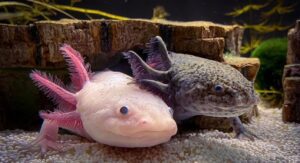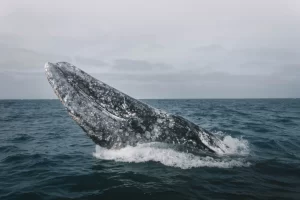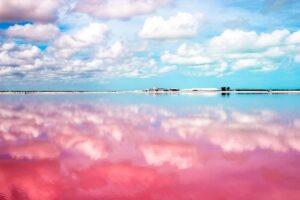Six Natural Reasons to Visit Mexico
México lindo y querido, our beloved country has more to offer in cultural, natural, and gastronomic experiences than you and even us Mexicans can imagine. From North to South, with many different ecosystems that give place to a huge variety of flora and fauna.
Historic landmarks created by the hand of Mother Nature, each one of them proudly represents us around the globe.
The Mexican Republic consists of 32 states, some close to the Caribbean Seas, others to the Gulf of Mexico, and some closer to the Pacific Ocean, with hills, mountains, valleys, forests, and deserts within. Imagine the diversity we have to offer.
This time, we are here to brag a little bit on behalf of Mother Nature, trying to show off some of the most beautiful natural assets we can find in different parts of these lands.
MONARCH BUTTERFLY SANCTUARIES
source: misanimales.com
To watch Monarch butterflies in their natural habitat is an extraordinary experience that fortunately we can live in Mexico.
Millions of these beautiful and colorful insects make an amazing three-month journey over 2,000 to 4,500 km. from Canada and the United States to various places in Mexico.
They do this to stay away from the winter, (like a lot of Canadians and Americans do). Every year millions of butterflies undertake the journey in August to arrive in November at the oyamel forests, which are 3 thousand meters above sea level, in Mexico. This type of forest is the ideal ecosystem for these insects due to its cool temperature, type of trees, clouds, and mist.
The sanctuaries located within the Monarch Butterfly Biosphere Reserve are open from November to March.
Biosphere Reserve Monarch Butterfly is located in the eastern part of the state of Michoacán and in the western part of the State of Mexico in the central zone. The reserve was created to protect the natural environment and habitat of the monarch butterfly having a total area of 57,259 hectares. It was declared a World Heritage Site by UNESCO in 2008, because the forests of oyamel, a fir tree native to the central mountains and southern Mexico, are the only types of ecosystems that can house monarch butterflies.
The tours to the sanctuaries, commonly guided by locals, consist of visits to the butterfly colonies going up kilometers of forest paths, accompanied by beautiful landscapes of coniferous forests, which can be done either on foot or on horseback. Most sanctuaries have ecological facilities, restaurants, craft shops, and adventure activities.
These tours are carried out under strict safety and hygiene measures, which must be followed by all tourists and service providers, in order to offer a safe and responsible stay. It is recommended to remain silent during your stay in the various sanctuaries, not to use flash to take pictures, and not to disturb, hold or capture butterflies. Likewise, do not introduce food, alcoholic beverages, sharp objects, firearms, or pets into the sanctuaries.
Monarch Butterfly’s most popular sanctuaries:
– El Rosario, in the municipality of Ocampo, in Michoacán
– Sierra Chincua, in Angangueo, Michoacán
– Senguio, in the municipality of the same name, in Michoacán
– El Capulín, on Cerro Pelón, municipality of Donato Guerra, State of Mexico
– San Mateo Almomoloa, in Piedra Herrada, State of Mexico.
MEXICAN AXOLOTL
source: animaladas.org
The Mexican axolotl or ajolote, is a salamander with the unusual characteristic of retaining its larval features in its adult life. This condition, known as neoteny, means that it retains its tadpole-like dorsal fin (which runs almost the entire length of its body) and its external gills, in feathery shape which come out from the back of its head. Axolotls are usually much more adapted to water than other species of salamanders.
The axolotl is usually black or mottled brown, although albino and white varieties are also relatively common, especially among captive-bred specimens. It can be quite large and reaches lengths of up to 30 centimeters, although its average size is 15 cm. It reaches up to 15 years of age feeding on mollusks, worms, insect larvae, crustaceans, and some fish.
We have to go back to the Mexicas to find the first records of the history of the axolotl, which was documented in various codices. In the scientific literature, it appeared in 1615 in a natural history book. According to Mexicas mythology, the axolotl (from Nahuatl: atl ‘water’ and xolotl ‘monster’, aquatic monster) is related to the god Xólotl, brother of Quetzalcóatl. Xolotl is associated with the idea of movement and life. He refused death, trying to hide in the cornfields and turning into a corn plant, however, he was discovered by the other gods and continued his flight. Finally, it was introduced to the water, where it transformed into an amphibian as its last metamorphosis. Thus Xolotl, the god who is afraid of death and who could not escape from it, went down in history for his powers of transformation.
This unique amphibian is critically endangered due to habitat loss, the introduction of invasive species, overexploitation, pollution, and its consumption as food.
The axolotl is found only in the lake complex of Xochimilco (Sochimilco), near Mexico City. In extremely rare cases, the axolotl matures and comes out of the water, but in most cases, they prefer to stay at the bottom of Xochimilco’s lakes, canals, and chinampas.
The chinampa is a cultivation method that was used by the Mexica to expand the territory in lakes and lagoons of the Valley of Mexico and in which they grew flowers and vegetables.
Lake Xochimilco and its chinampas, designed by Mexica farmers, were declared a World Heritage Site by UNESCO in 1987.
WHALE WATCHING IN BAJA CALIFORNIA SUR
source: americanoceans.org
Each year, various species of whales such as the humpback whale, the gray whale, and the blue whale undertake long migrations from their feeding grounds to their birthplaces in Mexico. Year after year, they travel to the lagoons of Baja California Sur where they stay for several months to mate and give birth.
There are few lagoons in the world where whales usually give birth to their babies, and three of them are in the Baja California Peninsula. These lagoons have warm waters that are protected from large predators (such as killer orcas) and from the strong waves and currents of the Pacific Ocean, creating a perfect environment. Here, mothers can nurse their newborn calves, and the shallow lagoons allow them to easily supervise them as they learn to swim, rise to the surface for air, and practice interacting with other whales.
Surprisingly, gray whales are extremely friendly and often seek out boats full of tourists to say hello. Adult gray whales reach almost 15 meters in length and 20 tons in weight. Their skin is grayish in color with irregular spots that differentiate them from the rest of the herd. This species does not have teeth, but “beards” through which they filter their food made up of microorganisms, algae, and other animals.
Gray whales, species protected by the International Whaling Commission, travel a route of more than 12 thousand kilometers starting from the sea of Alaska until they reach the Gulf of California. Their trip lasts almost three months and they usually stay in the Sea of Cortez from December to April, although the highest season for sightings is the months of February and March. After giving birth and teaching their young ones to swim, they head back north, where they live and feed for the rest of the year.
In addition, the gray whale is a Mexican species, since 90% of its calves are born on the coast of Baja California, and never forget their birthplace. Today it is known that there are around 25,000 extant specimens, a figure very similar to that of 170 years ago.
On the other hand, humpback whales make the second longest migration of all mammals on earth. They can make trips of up to ten thousand kilometers. The group that reaches the warm waters of Cabo San Lucas Bay comes from the cold waters of British Columbia, Washington State, and Northern California in the USA.
The diet of these species consists of small fish and krill or plankton. They mainly feed on copepods, euphausiids, amphipods, and other invertebrates such as shrimp, polychaetes, and squid. Also some species of fish such as anchovies, sardines, mackerel, and elasmobranchs. These are the marine mammals at the top of the food chain.
The largest percentage of whales observed in the waters of Cabo San Lucas are humpback whales. They represent 90% of sightings. The other 10% is divided into isolated sightings of gray whales and blue whales.
Once a refuge for conquistadors and pirates, Cabo San Lucas is now the most important tourist destination in Baja California Sur, Mexico. The prominent researcher Jacques Cousteau baptized the Sea of Cortez as “The World’s Aquarium”, as it houses countless fish, corals, and cetaceans.
Every winter, tourists visit the Peninsula to experience the unique feeling of seeing the whales. The sighting is done in small boats, where small groups of boats go out into the lagoons, turn off the motor and then wait. Minutes later, a blow, a whale, or even a mother with her calf is highly likely.
You can find tours of all kinds, such as small boats that can count on specialized guides, sailing agencies with higher quality service along with food and drinks, and larger boats that offer not only buffet food, but also an open bar, guides, and photographers.
WHALE-SHARK VISITS HOLBOX AND ISLA MUJERES
source: i.guim.co.uk
Of all the shark species, the whale shark is the one that is in the most contact with mankind and not precisely because of attacks, but because it lives with us at certain times of the year. From June to September, the law allows you to visit them, pamper them and swim with them.
These marine giants reach Caribbean seas such as Holbox Island or Isla Mujeres, because here the sea is rich in nutrients and has the most favorable conditions in the area for the growth of plankton on which they feed.
The whale shark is the largest fish in the world and can measure between 18-20 meters in length and has inhabited the oceans for 60 million years. It is also known as ‘domino fish’ because of the spots that stain its skin. When they are not sighted on the coasts, it is not clear where they go. It is believed that they make great migrations or simply move to deeper waters far from the coast. Large aggregations, involving more than 20 individuals, have only been seen occasionally in Asia. But only in the north of the Gulf of Mexico and in the Yucatan peninsula there has been sightings of groups of more than 50 individuals,
One issue that remains a mystery is the reproduction and mating of the whale shark. In 1995, a female captured in Taiwan whose womb was gestating 304 embryos in different stages of development was studied, with which it was known that it is an ovoviviparous species. But it has not been possible to observe their courtship rites or their mating or their breeding areas, which are supposed to be oceanic and deep.
The Whale Shark Biosphere Reserve and the Yum Balam Flora and Fauna Protection Area located in the seas of Quintana Roo, are the areas where the whale shark returns, for this reason, it is considered the sanctuary with the highest concentration of whale sharks species in the world. Its peculiar size and unparalleled beauty attract the eyes of many spectators eager to see it up close. As it is an endangered species, it is recommended to have a lot of respect and follow all the rules to be able to admire them without invading its habitat.
As for the Tours, it is best to book in advance because, as the season is very limited, so is the number of people who can swim daily with the sharks, this is for reasons of protection and care for the animals, although they are in the open sea, ships, boats, and visitors can cause some stress that could make them uncomfortable.
Prices may vary according to what the tour includes, but in general, the price of the tour to see the Shark is approximately 3,500 Mexican pesos, which will include a 5% donation for nature conservation projects in the Mayan area.
AGAVE LANDSCAPES IN GUADALAJARA, JALISCO
The region named a World Heritage Site by UNESCO in 2006 includes blue agave crops, distilleries, factories, taverns, clandestine distilleries from the colonial era, urban settlements of Tequila, Arenal, and Amatitlan, and the archaeological remains of Teuchitlan. It has an extension of 34,658 hectares between the Tequila Volcano and the deep valley of the Río Grande de Santiago in the state of Jalisco.
The agave fields themselves, with their rows of blue spears pointing everywhere, are the representative image, as is the individual agave, alone or accompanied by the jimador who removes the leaves with a coa.
You can find some vestiges of the Teuchitlán cultures that settled in the area, where the Guachimontones ceremonial center is located, which has several constructions of a particular architectural style since they are circular pyramids.
Some of the great tequila factories are more than a century old, although the history of tequila dates back to pre-Hispanic times when they discovered the sweet taste of agave pencas. Years later, they discovered that agave contained sugars that could form alcohol, they undertook the task of cooking the pencas to later ferment the juices and obtain the most that would later go through the distillation system that the Arabs had brought to Spain. This is how they obtained a drink called mezcal wine. In the case of the agave known by the scientific name of tequilana Weber, it has become famous in the world as a cultural phenomenon called Tequila.
The Town of Tequila is a Magical Town with a unique flavor, museums, and surrounded by natural beauties, where in addition to enjoying the traditional drink with all the tastings offered in the distilleries, you can enjoy the gastronomy and all the Mexican traditions from Jalisco.
You can make the trip to Tequila by boarding the Tequila Express, a train that leaves Guadalajara on Saturdays and Sundays. When you arrive in Tequila, a must-see is the National Tequila Museum, where you can learn in detail about the production process, as well as curious facts and an amazing collection of tequila bottles.
source: informarte.mx
LAS COLORADAS, YUCATAN’S PINK LAGOONS
Las Coloradas is a port in the Coast of Yucatan, in Rio Lagartos, North of Mérida. Apart from a small fishing community, it is one of the most important salt-producing sites in Mexico.
The high levels of salt in the waters of this area create the perfect condition for halobacteria to thrive, a type of bacteria that reacts to the sunlight by turning into different shades of pink and even red.
This amazing sight, the only pink lagoon in Mexico, has been a tourist attraction for the past few years, though it’s important not to swim in these waters because the amount of salt is toxic to your skin and eyes, and the chemicals you put on your skin will affect salt production, so visit and enjoy the sights, then go swim elsewhere.
source:gruposudesa.com.mx
Hopefully, you have added some more places to your Mexican bucket list, after getting to know a little bit more of the blessings Mother Nature has given to our country.
Stay tuned for more on Mexican Natural Wonders.
-Vagabond Abbey.












